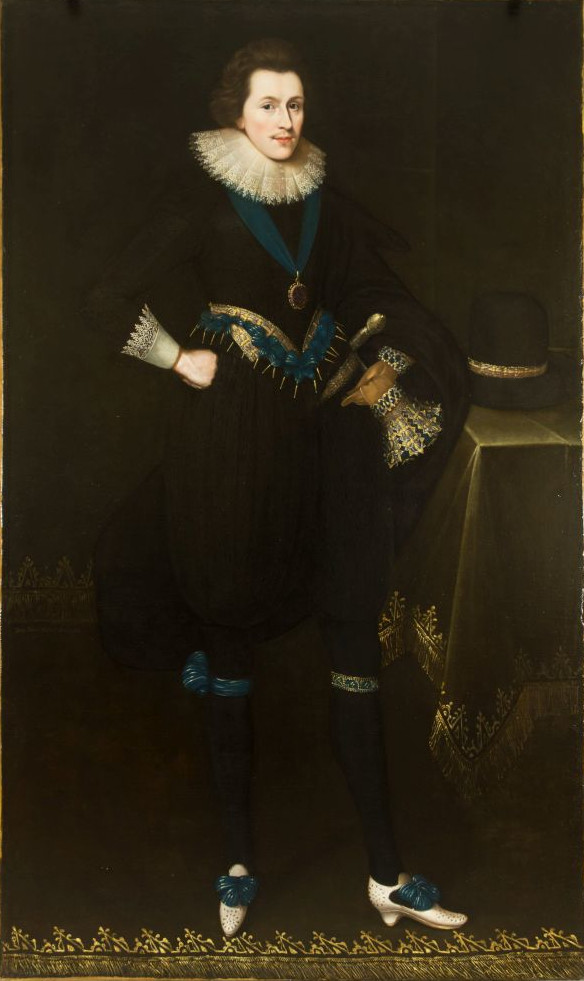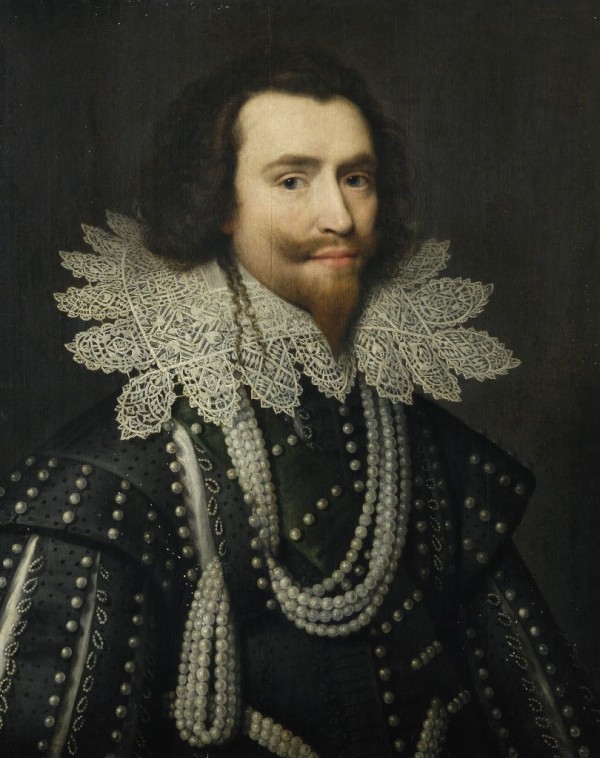Dressed for Success
Image was everything in the early 17th century court and Villiers had to make sure he looked the part.

Villiers is shown wearing the Lesser George Order of the Garter around his neck and the actual garter around his left knee. His doublet and breeches are made from a black silk or satin with a subtle pattern either woven into the fabric or the result of tiny slashes. The closely fitted doublet and the slightly looser breeches were tied together by the points – silk ribbons with metal aglets [tags] that by this date were often decorative rather than essential. There is a cloak over the left arm, possibly of a matching silk or a velvet. Many luxury fabrics such as lace, silk and velvet were imported, usually from Italy at this date, and were a sign of wealth and a wish to be fashionably dressed. Black was an expensive dye and although we associate it with mourning it was worn in other circumstances. However, if this portrait was painted after Queen Anne’s death in March 1619, it is possible that his sombre appearance reflects court mourning. The outfit may also have been an attempt to show Villiers as serious and conservative to his political critics.


His gloves are possibly made of soft Spanish leather. They have deep gauntlet cuffs of blue silk or satin with applied decoration of gold and silver embroidery in narrow bands. The area between the hand of the glove and the gauntlet is decorated with a matching band of ruffled ribbon. The elongated fingers were usual – these are display gloves, often signifying a gift, an event or an element of service. The wide gauntlet allows for the wrist cuffs not to be crushed or distorted and is usually lined with silk. Gloves and other garments were often scented – essential in an age when personal hygiene was limited; glovers often doubled as perfumers using ‘muske, Civet, Amber and spirit of Roses’.
There is a copotain hat on the table beside him. This has a high-crown and shallow brim with a handsome gold hatband that matches the girdle and sword hanger. Hats were worn by gentlemen even indoors and only removed in the presence of the monarch; this one is almost certainly made from felted beaver fur, the most expensive type of hat.


We commissioned Lisha Zhang, who worked as a ruff maker on the Sky UK series 'Mary & George' to design and make a replica ruff and set of cuffs based on those in our portrait. The ruff is a 'falling ruff' of a type fashionable in the early 1600s, probably made of cotton lawn and edged with Italian lace. It was probably dyed using a yellow starch. The replicas are now on display at Melton Carnegie Museum.


Reproduced by kind permission of the Syndics of Cambridge University Library
George Villiers, Duke of Buckingham, by Michiel Jansz. van Miereveld (1567–1641)
This painting shows Villiers in the 1620s wearing a suit sumptuously decorated with pearls. We know that in 1627 he sold the buttons from his pearl suit for £1,500 (the equivalent to almost £337,000 today) to raise funds to help pay sailors and provide supplies for a Naval expedition to France.

The richness of his clothing in our portrait from around 1619 shows how much his fortunes had changed. In 1615, he was described as being seen ‘at a horse race in Cambridgeshire in an old black suit, broken out in diverse places’.
As Royal favourite, Villiers had to maintain his status at Court by dressing richly and spending lavishly. His role as representative of the King in international affairs meant that he had to maintain an impressive wardrobe. For his visit to France to escort the Princess Henrietta Maria to England as King Charles I’s bride, he wore clothes as ‘rich as invention can frame, or art fashion, just one suit covered with diamonds was thought to be worth ‘four score thousand pound’.
We know he had an income of around £14,000 to £18,000 a year by 1620, the equivalent of £3.4 to £4.5 million pounds today. But he had members of his family to support and hospitality was a big expenditure, especially when entertaining the King and Prince.
With thanks to Valerie Cumming, Dress and Social Historian and Lisha Zhang, Ruff Designer and Maker.
